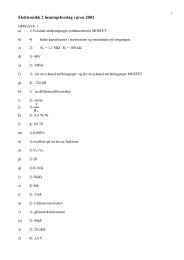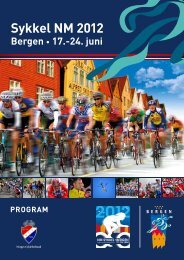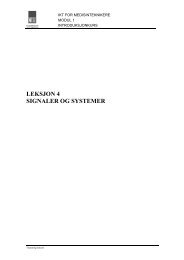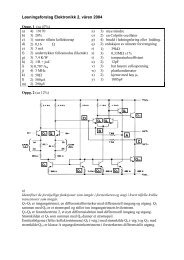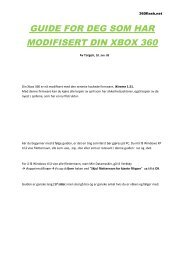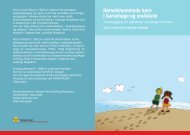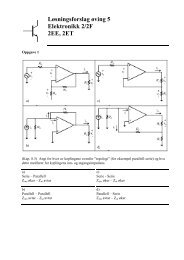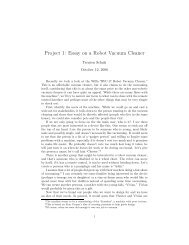The Online World resources handbook
The Online World resources handbook
The Online World resources handbook
Create successful ePaper yourself
Turn your PDF publications into a flip-book with our unique Google optimized e-Paper software.
Gazing into the future http://home.eunet.no/~presno/bok/17.html<br />
on a small PC by the fireplace in my living room. <strong>The</strong> computer is not much larger or<br />
heavier than a book.<br />
(Sources for monitoring notebook trends: Newsbytes' IBM and Apple reports, Ziff<br />
Davis' ZD Net).<br />
An update of MIT Media Lab's thinking on "News in the Future" can be found at<br />
http://nif.www.media.mit.edu/.<br />
Electronic news by radio<br />
Radio technology is being used to deliver Usenet newsgroup to bulletin boards<br />
(example: PageSat Inc. in the US). Also, consider this:<br />
Businesses need a constant flow of news to remain competitive. NewsEdge<br />
markets a real time news service called NewsEdge Live. <strong>The</strong>y call it "live news<br />
processing." It continuously collects news from hundreds of news wires, including<br />
sources like PR Newswire, Knight Ridder/Tribune Business News, Dow Jones News<br />
Service, Dow Jones Professional Investor Report, Reuters Financial News.<br />
<strong>The</strong> stories are "packaged" and immediately feed to customers' personal<br />
computers, workstations and intranets by FM, satellite, X.25 broadcast, or the Internet:<br />
All news stories are integrated in a live news stream all day long,<br />
<strong>The</strong> software manages the simultaneous receipt of news from multiple services,<br />
and alerts users to stories that match their individual interest profiles. It also<br />
maintains a full text database of the most recent 250,000 stories on the user's<br />
server for quick searching.<br />
Packet radio<br />
Global amateur radio networks allow users to modem around the world, and even in<br />
outer space. Its users never get a telephone bill. <strong>The</strong>y are specifically designed for email,<br />
and cannot be used to access interactive Internet services.<br />
<strong>The</strong>re are hundreds of packet radio based bulletin boards (PBBS). <strong>The</strong>y are<br />
interconnected by short wave radio, VHF, UHF, and satellite links. See<br />
http://www.wallycom.com/~wally/packet.html for information. Technology aside, they<br />
look and feel just like standard bulletin boards, and some of them also support TCP/IP,<br />
and have web pages.<br />
Once you have the equipment, can afford the electricity to power it up, and the<br />
time it takes to get a radio amateur license, communication itself is free. Typically, you'll<br />
need a radio (VHR tranceiver), antenna, cable for connecting the antenna to the radio,<br />
and a controller (TNC Terminal Node Controller).<br />
Most PBBS systems are connected to a network of packet radio based boards.<br />
Some amateurs use 1200 bps, but speeds of up to 56,000 bps are being used on higher<br />
frequencies.<br />
Hams are working on real time digitized voice communications, still frame (and<br />
even moving) graphics, and live multiplayer games. In some countries, there are<br />
gateways available to terrestrial public and commercial networks, such as Internet, and<br />
Usenet. Packet radio is proved as a possible technology for wireless extension of the<br />
Internet.<br />
Radio and satellites are being used to help countries in the Third <strong>World</strong>.<br />
Volunteers in Technical Assistance (VITA), a private, nonprofit organization, is one of<br />
those concerned with technology transfers in humanitarian aid to these countries.<br />
VITA's portable packet radio system was used for global email after a volcanic<br />
eruption in the Philippines in 1991. Today, the emphasis is on Africa.<br />
VITA's "space mailbox" passes over each single point of the earth twice every 25<br />
hours at an altitude of 800 kilometers. When the satellite is over a ground station, the<br />
station sends files and messages for storage in the satellite's computer memory and<br />
receives incoming mail. <strong>The</strong> cost of ground station operation is based on solar energy<br />
batteries, and therefore relatively cheap.<br />
To learn more about Vita's projects, subscribe to their mailing list by email to<br />
3 of 8 23.11.2009 15:49



